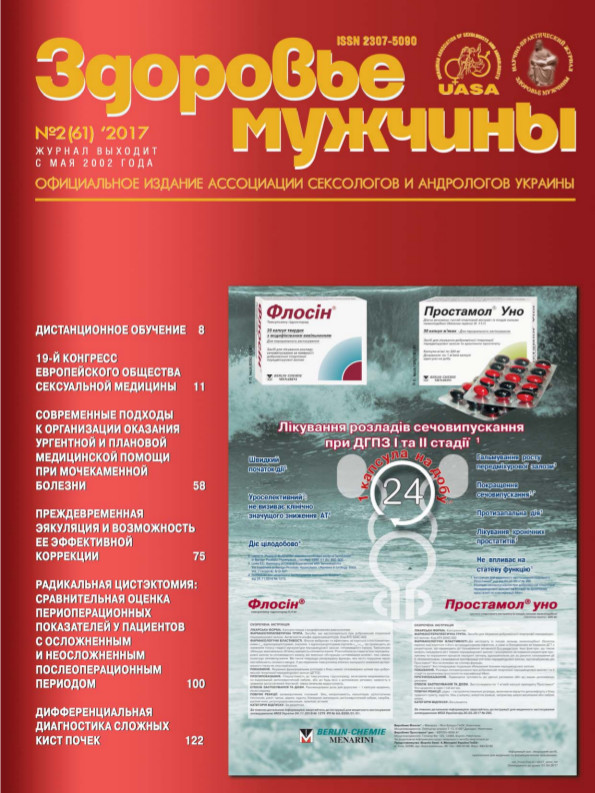The effectiveness of phytotherapy against the backq ground of the use of extracorporeal shock wave therapy in persons with chronic calculous prostatitis
##plugins.themes.bootstrap3.article.main##
Abstract
The objective: establish the clinical effectiveness of Canephron® N in individuals with chronic calculous prostatitis, as a component of complex therapy.
Patients and methods. In the department of andrology and sexology, the Institute of Urology of the National Academy of Medical Sciences of Ukraine, a study of the drug Canephron® N. was conducted in 30 patients (group I) with verified chronic calculous prostatitis (HCP), in the stage of unstable remission, aged 37 to 52 years 39,2±1,9 years), a complex treatment was performed in the form of extracorporeal shock wave therapy (ESWL), in combination with a daily dose of Canephron® N (90 days). Group II (n=30) consisted of patients with a similar condition (mean age 37,2±1,0 years) who received treatment in the form of ESWT and monotherapy with tamsulosin 0,4 mg/day for 30 days. The comparison group (group III) consisted of 15 patients with similar parameters, receiving only ESWT.
Results. The use of Canephron® N in complex HCV therapy with ESWT creates all the conditions for the implementation of antimicrobial, anti-inflammatory, antilithogenic and antispasmodic effects, with excellent compliance for 90 days. Its high compliance with the appointment in the form of anti-relapse courses of HCV therapy, with the possibility of effective correction of CPPS.
Conclusion. Complex therapy of patients with chronic calculous prostatitis, with the inclusion of Canephron® N in the herbal preparation, is a highly effective method of treatment. The use of Canephron® N in individuals with calculous prostatitis can reliably reduce the severity of the infectious-inflammatory reaction and improve the patient’s quality of life.
##plugins.themes.bootstrap3.article.details##

This work is licensed under a Creative Commons Attribution 4.0 International License.
Authors retain the copyright and grant the journal the first publication of original scientific articles under the Creative Commons Attribution 4.0 International License, which allows others to distribute work with acknowledgment of authorship and first publication in this journal.
References
Аляев Ю.Г., Амосов А.В. с соавт. Применение растительного препарата Канефрон Н у больных с хроническим циститом и мочекаменной болезнью //Урология. – 2005. – No 4. – С. 29–33.
Вощула В.И. Метафилактика мочекаменной болезни // Здоровье мужчины. – 2015. – 1 (52): 108–112.
Гресь А.А., Вощула В.И., Рыбина И.Л., Шлома Л.П. Мочекаменная болезнь: опыт применения и эффективность Канефрона// Медицинские новости. – 2004;8:89–93.
Гресь А.А. с соавт. Мочекаменная болезнь: опыт применения и эффективность Канефрона Н. // Медицинские новости. – 2004. –No 8. – С. 89–93.
Давидов М.И., Игошев А.М. (2015) Влияние растительного препарата Канефрон® Н на результаты дистанционной ударно-волновой литотрипсии. Эксперимент. клин. урол., 3: 82–86.
Иванов Д.Д., Назаренко В.И., Кушниренко С.В., и соавт. Терапевтические возможности препарата Канефрон Н при инфекциях мочевых путей у пациентов с сахарным диабетом типа 2 и метаболическим синдромом //Качество жизни. Медицина, No 3, 2006. /Iнфекции сечових шляxiв у дiтей та дорослих: Київ–Днiпропerровськ, Метод. реком., 2004. – 19 с.
Лапчинская И.И. В центре внимания нефрологов диабетическая нефропатия // Здоров’я України. – 2004. – No 6 (91). – 32 с.
Медведь В.И., Быкова Л.М., Данылкив О.Е., Шкабаровская Е.Н. Пиелонефрит у беременных с сахарным диабетом: особенности течения и лечения // Здоров’я Украiни. – 2003. – No 6 (67). – С. 22–23.
Перепанова Т.С., Хазан П.Л. Растительный препарат Канефрон Н в лечении и профилактике инфекций мочевых путей // Врачебное сословие. – 2005. – No 4–5. – С. 1–4.
Спиридоненко В.В. Хронічний калькульозний простатит: етіологія, патогенез, діагностика та сучасні методи лікування // Здоров’я України. – 2017. – No 3. – С. 7–8.
Черненко В.В., Савчук В.Й., Желтовская Н.И., Штильвасер Л.М. Особенности коррекции pН мочи и гиперкристаллурии у больных уратокаменной болезнью // Здоровье мужчины. – 2003. – No 4 (7). – С. 65–68.
Черненко В.В., Штильвасер Л.М., Желтовская Н.И. (2007) Современные подходы к про- и метафилактике мочекаменной болезни // Врач. сословие, 3: 20–23.
Ceban E. Efficacy of a fixed combination of Centaurii herba, Levistici radix and Rosmarini folium in. Zeitschrift fur Phytotherapie 2012; 33; 19–23.
Fahim F.A., Esmat A.X., Fadel H.M. et al. Allied studies on the effect of Rosmarinus officinalis L. on experimental hepatotoxity and mutagenesis // Int. J. Food Sci. Nutr. – 1999. – V. 50. – P. 413–427.
Gaybullaev factors of idiopathic calcium urolithiasis in an open study // Z. Phytotherapy 2013; 34: 16–20.
Ivanov et al. An open label, non-controlled, multicentre, interventional trial to investigate the safety and efficacy of Canephron® N in the management of uncomplicated urinary tract infections
(uUTIs).Clinical Phytoscience, 1:7 2015.
Martynyuk L., Ruzhitska O, Effect of the Herbal Combination Canephron N on Diabetic Nephropathy in Patients with Diabetes Mellitus: Results of a Comparative Cohort Study. The Journal of Alternative and Complementary Medicine 2014; 20(6): 472–8.
Medved V. Safety of Canephron® N for the treatment of urinary tract infections in the first trimester of pregnancy Clinical Phytoscience 1:11, 2015.
Milsom I., Abrams P., Cardozo L., Roberts R.G., Thuroff J., Wein A.J. // BJU Int. 2001;87:760–766.
Naber K.G. Efficacy and safety of the phytotherapeutic drug Canephron N in prevention and treatment of urogenital and gestational disease: review of clinical experience in Eastern Europe and Central Asia // Res. Rep. Urol. 2013; 5: 39–46.
Sterner W., Heisler E., Popp H.O. et al. Studies on the effectiveness of Canephron in renal diseases – Pharmacological and practical experiences. Phys Med Rehab 1973;14:239–258.
Yokoo Т., Kitamura M. Unexpected protection of glomerular mesangial cells from oxidant-triggered apoptosis by bioflavonoid quercetin //Am. J. Physiol. – 1997. – V. 273. – P. F206&F212.
Yokozawa Т., Dong E., Kawai Y., Gemba M. Protective effect of some flavonoids on the renal cellular membrane // Exp. Toxic. Pathol. – 1999. – V. 51. – P. 9–14.





